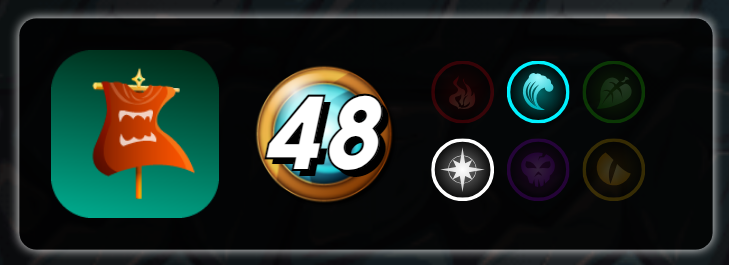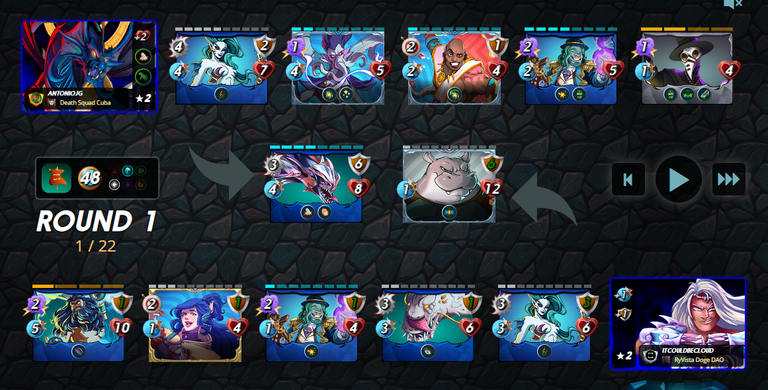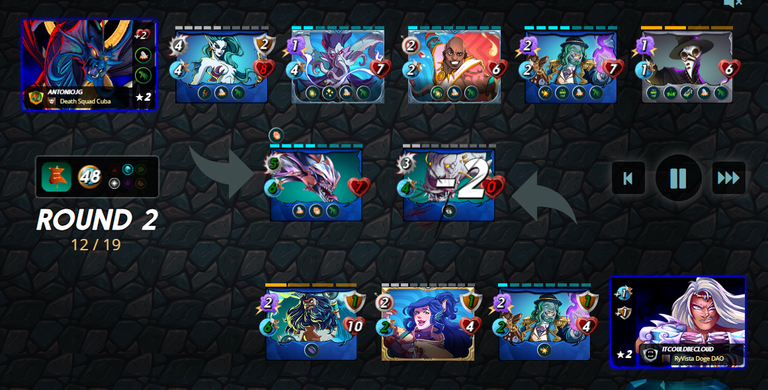Utilizando a Sanctus Vicar en una formación clásica con el Splinter de Agua [Es/En]

Español
¡Saludos comunidad! En el reto de esta semana quiero compartir con ustedes un análisis de mi experiencia utilizando una estrategia con la unidad Sanctus Vicar y el Splinter de Agua. La cual considero una excelente opción para aquellas partidas con un límite de maná alto y condiciones “Standard”. Es importante recordar que el tipo de ofensiva a utilizar en nuestras estrategias también dependerá del resto de reglas presentes en la batalla.
En esta oportunidad, les explicaré cómo afronté una batalla de Ranged de la liga de Plata en el formato Moderno, enfocando mi análisis en explicar cómo utilicé al Splinter de Agua, el invocador Possibilus the Wise y a las unidades Diemonshark, Coastal Sentry, Anasth Soothsayer, Sanctus Vicar, Riverboat Captain y Doctor Blight para ser coherente con las reglas de batalla presentes y las habilidades que quería combinar con la finalidad de tomar ventaja en la partida con la estrategia planteada.
Ya que estos aspectos son un factor clave con un impacto considerable en el desempeño de nuestras estrategias.

Conjunto de reglas y elección

Hablemos sobre el conjunto de reglas presentes en la batalla, este es el punto de partida para iniciar el análisis que nos llevará a la elección más adecuada para afrontar la batalla.
Límite de maná igual a 48 puntos, esta cantidad nos permite elegir invocadores con un costo de maná entre 4 y 7 puntos. Dejándonos con un maná restante suficiente para elegir las unidades adecuadas.
“Standard”, es una regla que no modifica ninguna característica en la batalla.
Entonces, tomando en cuenta todos estos aspectos, decidí elegir al Splinter de Agua, ya que cuenta con unidades que poseen buenas estadísticas, entre ellas, un buen daño melee, ranged y mágico. También cuenta con habilidades como: “Trample”, “Enrage”, “Double Strike”, “Tank Heal”, “Cleanse”, “Cleanse Rearguard”, “Blast”, Poison”, entre otras y con un invocador que incrementa en 2 puntos la vida del equipo, y les otorga las habilidades “Trample” y “Reach”.

Equipo y estrategia

Hablemos sobre el equipo y la estrategia que conforma. Dadas las circunstancias, era evidente el uso de cualquier tipo de ataque. Es por ello que decidí elegir al invocador Possibilus the Wise, ya que incrementa en 2 puntos la vida del equipo, y les otorga las habilidades “Trample” y “Reach”.
Diemonshark fue el tanque en esta oportunidad, ya que cuenta con buenas estadísticas, entre ellas, sus puntos de vida, armadura y daño melee. Además, posee las habilidades “Enrage” y “Trample”, las cuales le permiten aprovechar aún más cada ataque.
Coastal Sentry contribuye con su ataque desde la segunda línea pero con la particularidad de que puede atacar dos veces por turno, a través de la habilidad “Double Strike”. Lo que otorga una gran ventaja al equipo para debilitar al tanque enemigo.
Anasth Soothsayer tiene una participación clave en la batalla, ya que da soporte al tanque mediante las habilidades “Tank Heal” y “Cleanse”, permitiéndole resistir mucho más el daño enemigo.
Sanctus Vicar tiene el propósito de contribuir con su ataque ranged desde la segunda línea, ya que en esta oportunidad el enemigo no utilizó la habilidad “Silence” para reducir el daño mágico de mi equipo, por lo que la habilidad “Cleanse Rearguard” no pudo ser aprovechada en esta ocasión.
Riverboat Captain también lo consideró una unidad clave, ya que a través de la habilidad “Blast”, debilita gradualmente a la segunda línea enemiga.
Por último, Doctor Blight se encarga de darle ventaja al equipo una vez aplica las habilidades “Poison” y “Affliction”. Además, debilita gradualmente a las unidades enemigas con su ataque mágico.

Estrategia en acción

Como les mencioné anteriormente, elegir al invocador Possibilus the Wise y a las unidades Diemonshark, Coastal Sentry, Anasth Soothsayer, Sanctus Vicar, Riverboat Captain y Doctor Blight, fue una buena opción. Sin embargo, también es importante incluir habilidades de soporte que le permitan a nuestro tanque y al resto del equipo, resistir lo suficiente.
Observen como para el turno 12 de la ronda 2, el equipo enemigo estaba casi abatido. Diemonshark resistió muy bien en la primera posición, gracias al soporte de Anasth Soothsayer. Por otra parte, la contribución de Coastal Sentry, Sanctus Vicar, Riverboat Captain y Doctor Blight fue clave para debilitar al enemigo. Es importante resaltar que aunque Sanctus Vicar no utilizó su habilidad, de igual manera su contribución fue valiosa.
Si quieres ver la batalla completa, acá te dejo el enlace: CLIC PARA VER LA BATALLA

Conclusión
La estrategia planteada hizo un uso eficiente de la cantidad de maná disponible, cubriendo aspectos tales como: resistencia contra el daño enemigo, soporte del equipo, una buena ofensiva, y coherencia con el conjunto de reglas presente.
Una debilidad de esta estrategia es un equipo enemigo que cuente con resistencia al daño físico y mágico e incluya habilidades como: “Protect”, “Repair”, “Heal”, “Tank Heal”, “Shield”, “Void”, “Reflection Shield”, “Triage”, “Thorns”, “Demoralize”, entre otras. Además, es importante que el daño de la ofensiva supere la capacidad de curación de Anasth Soothsayer.
La diferencia entre las estrategias fue que el equipo enemigo no contaba con habilidades de soporte, por lo que terminó siendo abatido rápidamente.
Para el funcionamiento adecuado de nuestras estrategias, es importante considerar todos los aspectos involucrados, por lo que no sólo debemos enfocarnos en las estadísticas y habilidades a combinar. También debemos tener en cuenta la influencia de los conjuntos de reglas sobre la estrategia.
Este ha sido mi aporte al desafío semanal, ¡Espero haya sido de su agrado! ¡Saludos y hasta la próxima semana!

English
Greetings community! In this week's challenge I want to share with you an analysis of my experience using a strategy with the Sanctus Vicar unit and the Water Splinter. Which I consider an excellent option for those games with a high mana limit and “Standard” conditions. It is important to remember that the type of offensive to use in our strategies will also depend on the rest of the rules present in the battle.
In this opportunity, I will explain how I faced a Silver League Ranged battle in the Modern format, focusing my analysis in explaining how I used the Water Splinter, the summoner Possibilus the Wise and the units Diemonshark, Coastal Sentry, Anasth Soothsayer, Sanctus Vicar, Riverboat Captain and Doctor Blight to be coherent with the battle rules present and the abilities I wanted to combine in order to take advantage in the game with the strategy proposed.
Since these aspects are a key factor with a considerable impact on the performance of our strategies.

Rulesets and choise

Let's talk about the set of rules present in the battle, this is the starting point to begin the analysis that will lead us to the most appropriate choice to face the battle.
Mana limit equal to 48 points, this amount allows us to choose summoners with a mana cost between 4 and 7 points. Leaving us with enough remaining mana to choose the right units.
“Standard”, is a rule that does not modify any characteristic in battle.
So, taking into account all these aspects, I decided to choose the Water Splinter, since it has units with good stats, including good melee, ranged and magic damage. It also has abilities such as: “Trample”, “Enrage”, “Double Strike”, “Tank Heal”, “Cleanse”, “Cleanse Rearguard”, “Blast”, “Poison”, among others, and a summoner that increases the team's life by 2 points, and gives them the abilities “Trample” and “Reach”.

Team and strategy

Let's talk about the team and its strategy. Given the circumstances, it was obvious to use any type of attack. That's why I decided to choose the summoner Possibilus the Wise, since it increases the team's life by 2 points, and gives them the “Trample” and “Reach” abilities.
Diemonshark was the tank in this opportunity, since he has good stats, among them, his health points, armor and melee damage. In addition, he has the “Enrage” and “Trample” abilities, which allow him to take advantage of each attack even more.
Coastal Sentry contributes with its attack from the second line but with the particularity that it can attack twice per turn, through the “Double Strike” ability. This gives the team a great advantage to weaken the enemy tank.
Anasth Soothsayer has a key role in the battle, as it gives support to the tank through the “Tank Heal” and “Cleanse” abilities, allowing it to resist enemy damage much more.
Sanctus Vicar has the purpose of contributing with his ranged attack from the second line, since this time the enemy did not use the “Silence” skill to reduce the magic damage of my team, so the “Cleanse Rearguard” skill could not be used this time.
Riverboat Captain also considered him a key unit, since through the “Blast” ability, he gradually weakens the enemy second line.
Finally, Doctor Blight is in charge of giving the team an advantage once he applies the “Poison” and “Affliction” abilities. In addition, he gradually weakens the enemy units with his magic attack.

Strategy in action

As I mentioned before, choosing the summoner Possibilus the Wise and the units Diemonshark, Coastal Sentry, Anasth Soothsayer, Sanctus Vicar, Riverboat Captain and Doctor Blight was a good choice. However, it is also important to include support abilities that allow our tank and the rest of the team to resist enough.
Note how by turn 12 of round 2, the enemy team was almost down. Diemonshark resisted very well in the first position, thanks to the support of Anasth Soothsayer. On the other hand, the contribution of Coastal Sentry, Sanctus Vicar, Riverboat Captain and Doctor Blight was key to weaken the enemy. It is important to note that although Sanctus Vicar did not use his ability, his contribution was still valuable.
If you want to see the complete battle, here you have the link: CLICK TO WATCH THE BATTLE

Conclusion
The strategy proposed made efficient use of the amount of mana available, covering aspects such as: resistance against enemy damage, team support, good offense, and coherence with the present set of rules.
A weakness of this strategy is an enemy team that has resistance to physical and magical damage and includes abilities such as: “Protect”, “Repair”, “Heal”, “Tank Heal”, “Shield”, “Void”, “Reflection Shield”, “Triage”, “Thorns”, “Demoralize”, among others. In addition, it is important that the offensive damage exceeds the healing capacity of Anasth Soothsayer.
The difference between the strategies was that the enemy team did not have support abilities, so they ended up being quickly defeated.
For the proper functioning of our strategies, it is important to consider all the aspects involved, so we should not only focus on the stats and skills to combine. We must also take into account the influence of the rule sets on the strategy.
This has been my contribution to the weekly challenge, I hope you enjoyed it, greetings and see you next week!

Te invito a seguirme en / I invite you to follow me on: Twitter
Las traducciones fueron realizadas con el traductor / Translations were done with the translator: DeepL
Todas las imágenes fueron tomadas de / and all images were taken from: Splinterlands

https://x.com/AntonioJGB92/status/1840089674406101429
https://www.reddit.com/r/Splinterlands/comments/1frk80l/utilizando_a_sanctus_vicar_en_una_formación/
The rewards earned on this comment will go directly to the people( @antoniojg ) sharing the post on Reddit as long as they are registered with @poshtoken. Sign up at https://hiveposh.com.
¡Felicitaciones!
1. Invierte en el PROYECTO ENTROPÍA y recibe ganancias semanalmente. Entra aquí para más información.
3. Suscríbete a nuestra COMUNIDAD, apoya al trail de @Entropia y así podrás ganar recompensas de curación de forma automática. Entra aquí para más información sobre nuestro trail.
4. Creación de cuentas nuevas de Hive aquí.
5. Visita nuestro canal de Youtube.
Atentamente
El equipo de curación del PROYECTO ENTROPÍA
Thanks for sharing! - @mango-juice

¡Gracias! | Thanks! ✌️